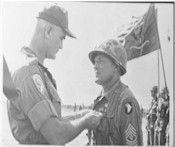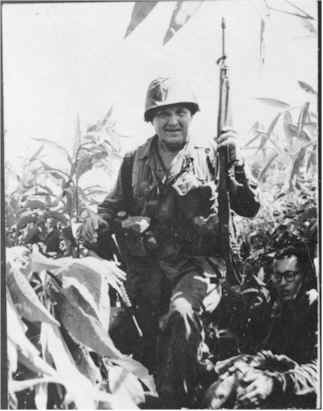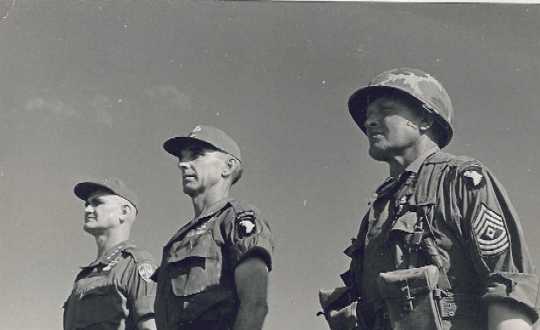Courtesy of the United States Army:
CSM WALTER J. SABALAUSKI
(1910 – 1993)
Walter James Sabalauski was born in Lithuania in 1910. His family moved to the United States while he was a small child. From 1929 to 1937, he boxed professionally while living in the Chicago area. An auto accident ended his career with an outstanding record of only two defeats in 33 bouts.
Command Sergeant Major Sabalauski entered the Army in June 1941. During World War II, he served in the Pacific Theater, fighting on the beachheads of the Solomon Islands, Guadalcanal, and the Philippines. He later served in the Korean War with the 187th Regimental Combat Team (Airborne) and 25th Infantry Regiment. In 1963, CSM Sabalauski went to Vietnam for the first time, where he served as an advisor to the 32d Vietnamese Ranger Battalion. After service in the Dominican Republic in 1965, he returned to Vietnam in 1966. It was during this tour that he fought his most memorable battle.
Early in June of 1966, Charlie Company, 2d Battalion, 502d Infantry Regiment was conducting a mission to locate elements of the 24th North Vietnamese Regiment. Charlie Company made contact with what was estimated to be a battalion-sized enemy element. Under heavy enemy fire and unable to maneuver, the company commander, CPT William Carpenter called for air strikes in his position in an attempt to force the enemy to withdraw. The enemy ceased fire long enough to allow Charlie Company to consolidate, reorganize and establish a position from which to defend and begin evacuation of wounded personnel. 1SG Sabalauski, in utter disregard for his own safety, repeatedly placed himself at risk for the sake of his soldiers during the conduct of this mission. For his extraordinary heroism in destroying the enemy and in evacuation the mass causalities, he received both the Distinguished Service Cross and the Silver Star.
After his second tour in Vietnam he returned to the United States to serve as Cadet Regimental Sergeant Major at West Point. In 1968, he again returned to Vietnam and the 2-502d Infantry Regiment. Command Sergeant Major Sabalauski continued to serve until 1971 when he retired at the age of 61.
Command Sergeant Major Sabalauski’s awards include the Distinguished Service Cross, Silver Star, Legion of Merit, 8 Bronze Stars, 3 Air Medals, 6 Army Commendation Medals, 4 Purple Hearts, 3 Awards of the Combat Infantryman’s Badge, the Master Parachutist Badge along with campaign medals for service in World War II, Korea, Dominican Republic, and Vietnam.
Command Sergeant Major Sabalauski died in 1993 and was buried with full military honors in Arlington National Cemetery. To the soldiers who served with him, he is remembered as a fearless leader in combat and as having a heart as big as any country in which he served.
SABALAUSKI, WALTER JAMES
First Sergeant, U.S. Army
Company C, 2d Battalion, 502nd Infantry Regiment, 1st Brigade, 101st Airborne Division
Date of Action: June 9 – 11, 1966
HQ US Army, Vietnam, General Orders No. 5821 (September 27, 1966)
Synopsis:
The Distinguished Service Cross is presented to Walter James Sabalauski, First Sergeant, U.S. Army, for extraordinary heroism in connection with military operations involving conflict with an armed hostile force in the Republic of Vietnam, while serving with Company C, 2d Battalion, 502d Infantry, 1st Brigade, 101st Airborne Division.
First Sergeant Sabalauski distinguished himself by exceptionally valorous actions during the period 9 to 11 June 1966 while participating in a blocking operation near Dak To. When the Viet Cong occupied jungle suddenly erupted with intense hostile fire from three directions, First Sergeant Sabalauski, realizing that the company commander could not possibly control all the elements in the thick bamboo growth and 50 foot canopies, rallied and directed the beleaguered troops in an attempt to gain fire superiority. With complete disregard for his safety, First Sergeant Sabalauski dashed from position to position and repeatedly exposed himself to muster his unit and quell the hostile fire. As the Viet Cong assaulted the perimeter, First Sergeant Sabalauski quickly organized an assault line and delivered suppressive fire onto the fanatical Viet Cong. After dashing to the rear of the perimeter and observing that the insurgents were surrounding his company, he exposed himself and screamed orders to form a tight defensive perimeter. Although artillery was called in as close as 25 meters from the friendly force and air strikes devastated the jungle around the perimeter, the determined Viet Cong continued to advance.
When the company commander called in air strikes on his own position as a last resort, First Sergeant Sabalauski remained on his feet to control the beleaguered paratroopers. For 30 hours, he continued to dash from one side of the perimeter to the other to direct and encourage his men. Although he was wounded himself, First Sergeant Sabalauski aided his wounded comrades, comforted the dying, and continued to direct his men. When reinforcements arrived and a hasty perimeter was again set up, he fearlessly moved forward of the perimeter and retrieved a dead comrade. After a 1,000 meter move to an evacuation point, First Sergeant Sabalauski personally supervised the extraction of the wounded and dead. Through his courage and outstanding leadership throughout the long and perilous battle, he contributed immeasurable to the success of his mission.
First Sergeant Sabalauski’s extraordinary heroism and devotion to duty were in keeping with the highest traditions of the military service and reflect great credit upon himself, his unit, and the United States Army.
Combat Infantryman’s Badge (3)
Note From John Yeager, Jr.: Enclosed is a picture of “Sab.” The Army’s Air Assault School is named after him. The others in the photo are General Westmoreland and Brigadier General Willard Pearson. The occasion is the ceremony where Sab was awarded the DSC for the battle of Dak To. He was burned by napalm there when air support was called in to keep Company “C,” 2d Battalion (Airborne) of the 502d Infantry from being overrun.
Michael Robert Patterson was born in Arlington and is the son of a former officer of the US Army. So it was no wonder that sooner or later his interests drew him to American history and especially to American military history. Many of his articles can be found on renowned portals like the New York Times, Washingtonpost or Wikipedia.
Reviewed by: Michael Howard





